Business Decision Making
VerifiedAdded on 2023/01/06
|9
|1592
|22
AI Summary
This study discusses the importance of decision making in business and explores the application of investment appraisal techniques like NPV and payback period. It also highlights the financial and non-financial factors that influence investment decisions.
Contribute Materials
Your contribution can guide someone’s learning journey. Share your
documents today.

Business Decision Making
Secure Best Marks with AI Grader
Need help grading? Try our AI Grader for instant feedback on your assignments.

Table of Contents
INTRODUCTION...........................................................................................................................3
TASKS.............................................................................................................................................3
Computation of:......................................................................................................................3
1 .Payback period:.................................................................................................................3
2. NPV:...................................................................................................................................4
Analysis:.................................................................................................................................6
CONCLUSION................................................................................................................................8
REFERENCES................................................................................................................................9
INTRODUCTION...........................................................................................................................3
TASKS.............................................................................................................................................3
Computation of:......................................................................................................................3
1 .Payback period:.................................................................................................................3
2. NPV:...................................................................................................................................4
Analysis:.................................................................................................................................6
CONCLUSION................................................................................................................................8
REFERENCES................................................................................................................................9
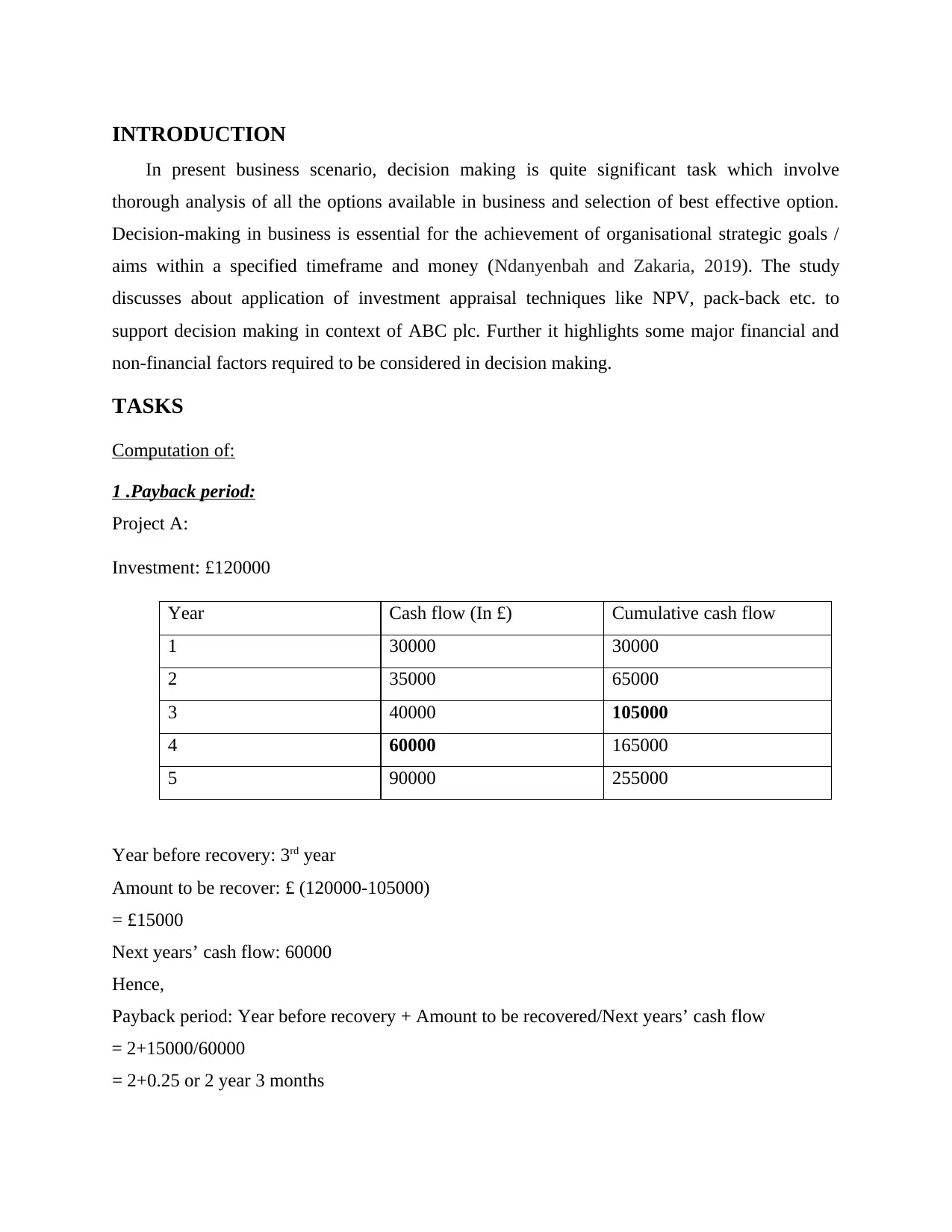
INTRODUCTION
In present business scenario, decision making is quite significant task which involve
thorough analysis of all the options available in business and selection of best effective option.
Decision-making in business is essential for the achievement of organisational strategic goals /
aims within a specified timeframe and money (Ndanyenbah and Zakaria, 2019). The study
discusses about application of investment appraisal techniques like NPV, pack-back etc. to
support decision making in context of ABC plc. Further it highlights some major financial and
non-financial factors required to be considered in decision making.
TASKS
Computation of:
1 .Payback period:
Project A:
Investment: £120000
Year Cash flow (In £) Cumulative cash flow
1 30000 30000
2 35000 65000
3 40000 105000
4 60000 165000
5 90000 255000
Year before recovery: 3rd year
Amount to be recover: £ (120000-105000)
= £15000
Next years’ cash flow: 60000
Hence,
Payback period: Year before recovery + Amount to be recovered/Next years’ cash flow
= 2+15000/60000
= 2+0.25 or 2 year 3 months
In present business scenario, decision making is quite significant task which involve
thorough analysis of all the options available in business and selection of best effective option.
Decision-making in business is essential for the achievement of organisational strategic goals /
aims within a specified timeframe and money (Ndanyenbah and Zakaria, 2019). The study
discusses about application of investment appraisal techniques like NPV, pack-back etc. to
support decision making in context of ABC plc. Further it highlights some major financial and
non-financial factors required to be considered in decision making.
TASKS
Computation of:
1 .Payback period:
Project A:
Investment: £120000
Year Cash flow (In £) Cumulative cash flow
1 30000 30000
2 35000 65000
3 40000 105000
4 60000 165000
5 90000 255000
Year before recovery: 3rd year
Amount to be recover: £ (120000-105000)
= £15000
Next years’ cash flow: 60000
Hence,
Payback period: Year before recovery + Amount to be recovered/Next years’ cash flow
= 2+15000/60000
= 2+0.25 or 2 year 3 months
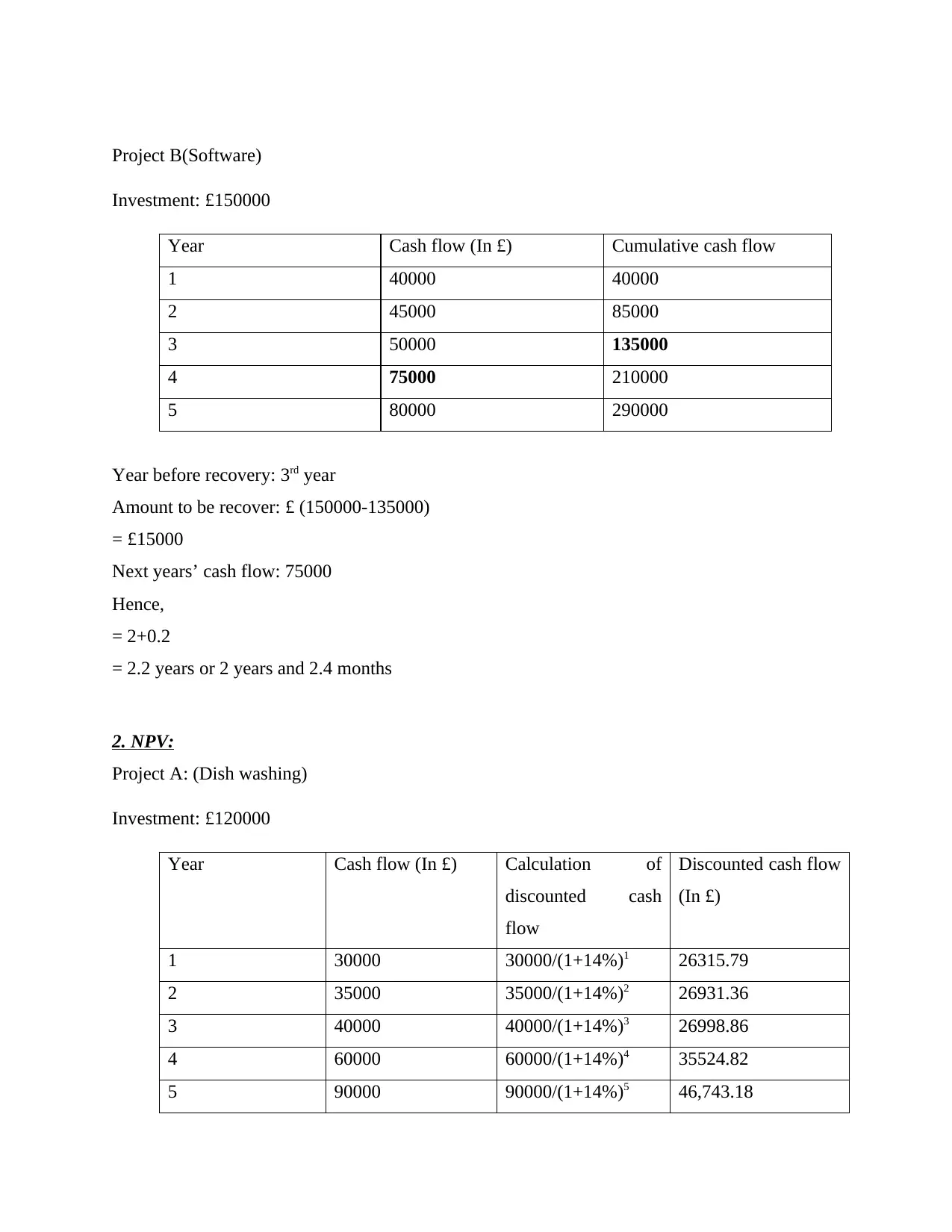
Project B(Software)
Investment: £150000
Year Cash flow (In £) Cumulative cash flow
1 40000 40000
2 45000 85000
3 50000 135000
4 75000 210000
5 80000 290000
Year before recovery: 3rd year
Amount to be recover: £ (150000-135000)
= £15000
Next years’ cash flow: 75000
Hence,
= 2+0.2
= 2.2 years or 2 years and 2.4 months
2. NPV:
Project A: (Dish washing)
Investment: £120000
Year Cash flow (In £) Calculation of
discounted cash
flow
Discounted cash flow
(In £)
1 30000 30000/(1+14%)1 26315.79
2 35000 35000/(1+14%)2 26931.36
3 40000 40000/(1+14%)3 26998.86
4 60000 60000/(1+14%)4 35524.82
5 90000 90000/(1+14%)5 46,743.18
Investment: £150000
Year Cash flow (In £) Cumulative cash flow
1 40000 40000
2 45000 85000
3 50000 135000
4 75000 210000
5 80000 290000
Year before recovery: 3rd year
Amount to be recover: £ (150000-135000)
= £15000
Next years’ cash flow: 75000
Hence,
= 2+0.2
= 2.2 years or 2 years and 2.4 months
2. NPV:
Project A: (Dish washing)
Investment: £120000
Year Cash flow (In £) Calculation of
discounted cash
flow
Discounted cash flow
(In £)
1 30000 30000/(1+14%)1 26315.79
2 35000 35000/(1+14%)2 26931.36
3 40000 40000/(1+14%)3 26998.86
4 60000 60000/(1+14%)4 35524.82
5 90000 90000/(1+14%)5 46,743.18
Secure Best Marks with AI Grader
Need help grading? Try our AI Grader for instant feedback on your assignments.
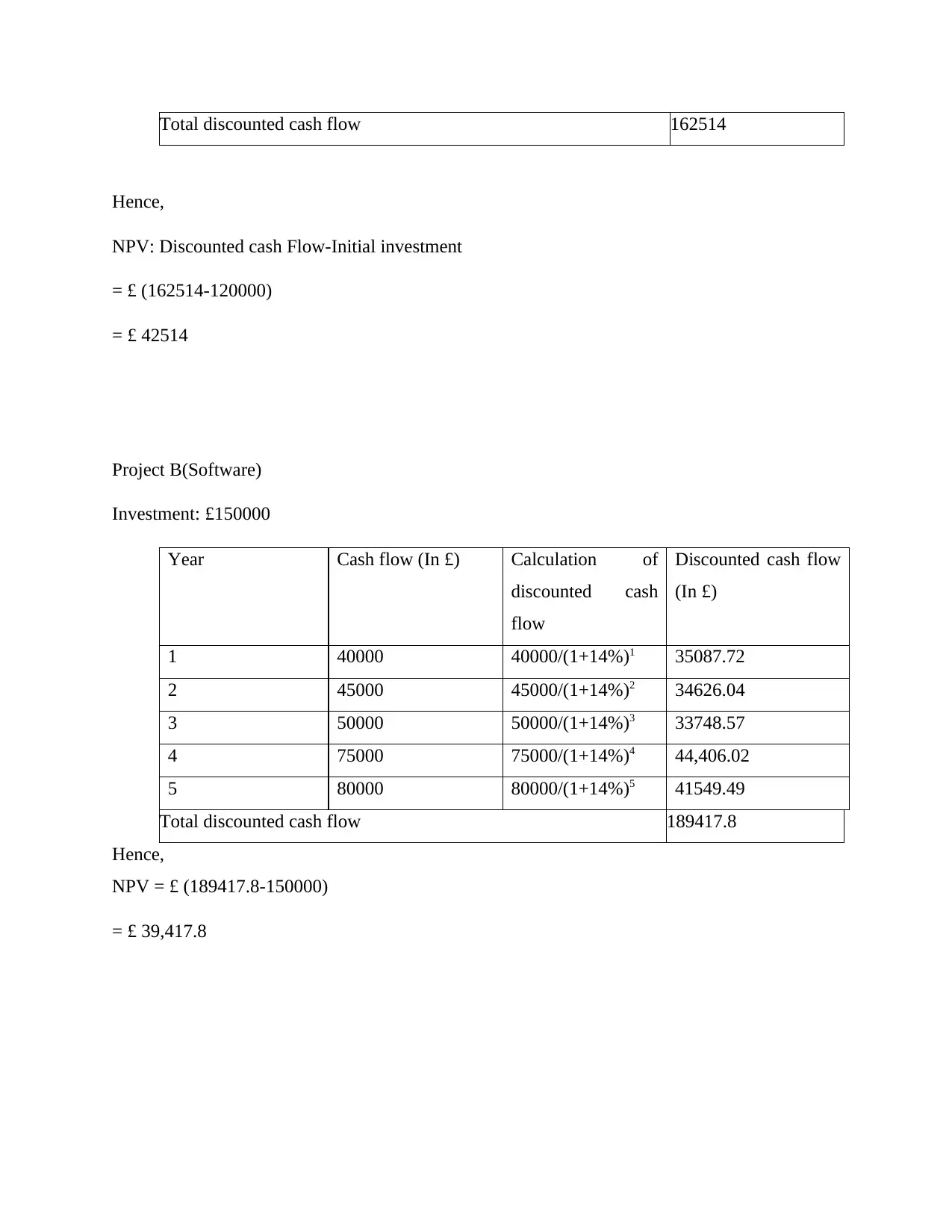
Total discounted cash flow 162514
Hence,
NPV: Discounted cash Flow-Initial investment
= £ (162514-120000)
= £ 42514
Project B(Software)
Investment: £150000
Year Cash flow (In £) Calculation of
discounted cash
flow
Discounted cash flow
(In £)
1 40000 40000/(1+14%)1 35087.72
2 45000 45000/(1+14%)2 34626.04
3 50000 50000/(1+14%)3 33748.57
4 75000 75000/(1+14%)4 44,406.02
5 80000 80000/(1+14%)5 41549.49
Total discounted cash flow 189417.8
Hence,
NPV = £ (189417.8-150000)
= £ 39,417.8
Hence,
NPV: Discounted cash Flow-Initial investment
= £ (162514-120000)
= £ 42514
Project B(Software)
Investment: £150000
Year Cash flow (In £) Calculation of
discounted cash
flow
Discounted cash flow
(In £)
1 40000 40000/(1+14%)1 35087.72
2 45000 45000/(1+14%)2 34626.04
3 50000 50000/(1+14%)3 33748.57
4 75000 75000/(1+14%)4 44,406.02
5 80000 80000/(1+14%)5 41549.49
Total discounted cash flow 189417.8
Hence,
NPV = £ (189417.8-150000)
= £ 39,417.8

Analysis:
NPV: Net present value is an approach that companies often use when considering actual or
prospective investment projects. This approach helps to assess whether return on invested capital
is higher or lower for a particular product/service. This approach relies on current value of
monies relative to the final return of the cash result. The rationale that NPV approach is often
used as a guide for financial experts is that this measures time value of monies and makes a clear
distinction between initial capital investment and the actual return on investment (Kengatharan
and Clamenthu, 2017). Here are several key merits and demerits of this approach as follows:
Merits:
The important merit of the NPV technique is that it considers concept that an upcoming
years pound would worth lower than a pound as on current date. In each time frame, funds flows
under NPV is discounted at rate for a further duration of capital-costs. The NPV approach also
convinces us whether a particular long-term investment would produce values for the
business including how much in monetary terms.
Demerits:
The NPV approach is not effective for evaluating two proposals of dissimilar sizes. Since
the NPV approach resulting in a pound’s response, sum of net present value is largely
ascertained by size of inputs. Further, it needs some wild speculation on the company's capital
cost. Considering that capital costs are too low would lead in suboptimal spending. Considering
that capital costs are too high would lead in very many productive investments being made.
Based on above calculations this has been ascertained that project has comparatively
greater amount of NPV that is £ 42514 thus this project will provide more effective returns.
Payback-Period: Payback period is time taken to pay us back initial investment in specific
project. Payback can be calculated in month terms as well as years, but based on a project
duration, any time period may be used. It focuses on money flows and points at investment's
accumulated cash flows to the period where the initial investment being recovered
from investment cash inflow. Following are certain demerits and merits of this technique, as
described below:
Merits: It is fast and quick to compute payback period and the outcomes are convenient to
comprehend. It is targeted at cash flows which is good for companies with restricted capital. This
NPV: Net present value is an approach that companies often use when considering actual or
prospective investment projects. This approach helps to assess whether return on invested capital
is higher or lower for a particular product/service. This approach relies on current value of
monies relative to the final return of the cash result. The rationale that NPV approach is often
used as a guide for financial experts is that this measures time value of monies and makes a clear
distinction between initial capital investment and the actual return on investment (Kengatharan
and Clamenthu, 2017). Here are several key merits and demerits of this approach as follows:
Merits:
The important merit of the NPV technique is that it considers concept that an upcoming
years pound would worth lower than a pound as on current date. In each time frame, funds flows
under NPV is discounted at rate for a further duration of capital-costs. The NPV approach also
convinces us whether a particular long-term investment would produce values for the
business including how much in monetary terms.
Demerits:
The NPV approach is not effective for evaluating two proposals of dissimilar sizes. Since
the NPV approach resulting in a pound’s response, sum of net present value is largely
ascertained by size of inputs. Further, it needs some wild speculation on the company's capital
cost. Considering that capital costs are too low would lead in suboptimal spending. Considering
that capital costs are too high would lead in very many productive investments being made.
Based on above calculations this has been ascertained that project has comparatively
greater amount of NPV that is £ 42514 thus this project will provide more effective returns.
Payback-Period: Payback period is time taken to pay us back initial investment in specific
project. Payback can be calculated in month terms as well as years, but based on a project
duration, any time period may be used. It focuses on money flows and points at investment's
accumulated cash flows to the period where the initial investment being recovered
from investment cash inflow. Following are certain demerits and merits of this technique, as
described below:
Merits: It is fast and quick to compute payback period and the outcomes are convenient to
comprehend. It is targeted at cash flows which is good for companies with restricted capital. This
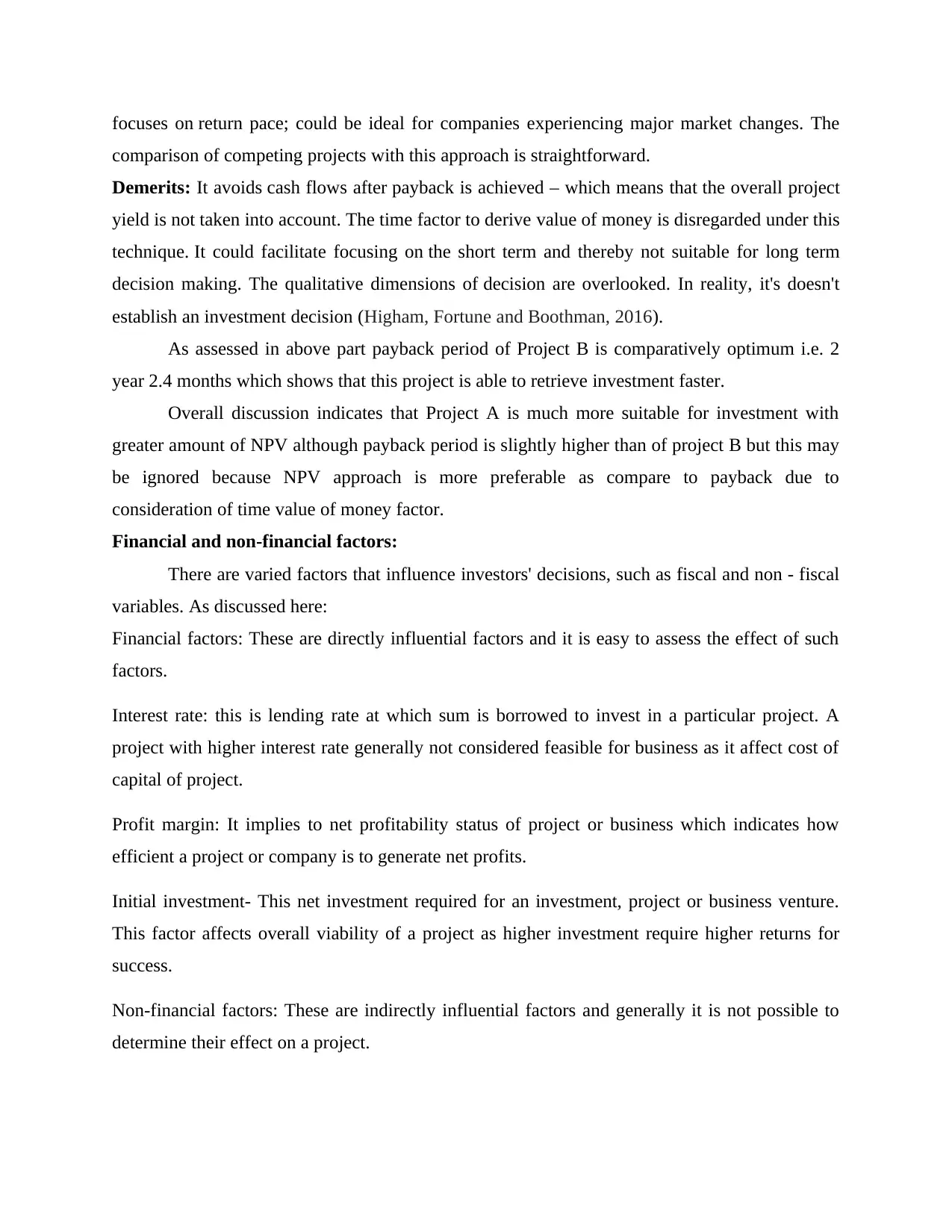
focuses on return pace; could be ideal for companies experiencing major market changes. The
comparison of competing projects with this approach is straightforward.
Demerits: It avoids cash flows after payback is achieved – which means that the overall project
yield is not taken into account. The time factor to derive value of money is disregarded under this
technique. It could facilitate focusing on the short term and thereby not suitable for long term
decision making. The qualitative dimensions of decision are overlooked. In reality, it's doesn't
establish an investment decision (Higham, Fortune and Boothman, 2016).
As assessed in above part payback period of Project B is comparatively optimum i.e. 2
year 2.4 months which shows that this project is able to retrieve investment faster.
Overall discussion indicates that Project A is much more suitable for investment with
greater amount of NPV although payback period is slightly higher than of project B but this may
be ignored because NPV approach is more preferable as compare to payback due to
consideration of time value of money factor.
Financial and non-financial factors:
There are varied factors that influence investors' decisions, such as fiscal and non - fiscal
variables. As discussed here:
Financial factors: These are directly influential factors and it is easy to assess the effect of such
factors.
Interest rate: this is lending rate at which sum is borrowed to invest in a particular project. A
project with higher interest rate generally not considered feasible for business as it affect cost of
capital of project.
Profit margin: It implies to net profitability status of project or business which indicates how
efficient a project or company is to generate net profits.
Initial investment- This net investment required for an investment, project or business venture.
This factor affects overall viability of a project as higher investment require higher returns for
success.
Non-financial factors: These are indirectly influential factors and generally it is not possible to
determine their effect on a project.
comparison of competing projects with this approach is straightforward.
Demerits: It avoids cash flows after payback is achieved – which means that the overall project
yield is not taken into account. The time factor to derive value of money is disregarded under this
technique. It could facilitate focusing on the short term and thereby not suitable for long term
decision making. The qualitative dimensions of decision are overlooked. In reality, it's doesn't
establish an investment decision (Higham, Fortune and Boothman, 2016).
As assessed in above part payback period of Project B is comparatively optimum i.e. 2
year 2.4 months which shows that this project is able to retrieve investment faster.
Overall discussion indicates that Project A is much more suitable for investment with
greater amount of NPV although payback period is slightly higher than of project B but this may
be ignored because NPV approach is more preferable as compare to payback due to
consideration of time value of money factor.
Financial and non-financial factors:
There are varied factors that influence investors' decisions, such as fiscal and non - fiscal
variables. As discussed here:
Financial factors: These are directly influential factors and it is easy to assess the effect of such
factors.
Interest rate: this is lending rate at which sum is borrowed to invest in a particular project. A
project with higher interest rate generally not considered feasible for business as it affect cost of
capital of project.
Profit margin: It implies to net profitability status of project or business which indicates how
efficient a project or company is to generate net profits.
Initial investment- This net investment required for an investment, project or business venture.
This factor affects overall viability of a project as higher investment require higher returns for
success.
Non-financial factors: These are indirectly influential factors and generally it is not possible to
determine their effect on a project.
Paraphrase This Document
Need a fresh take? Get an instant paraphrase of this document with our AI Paraphraser
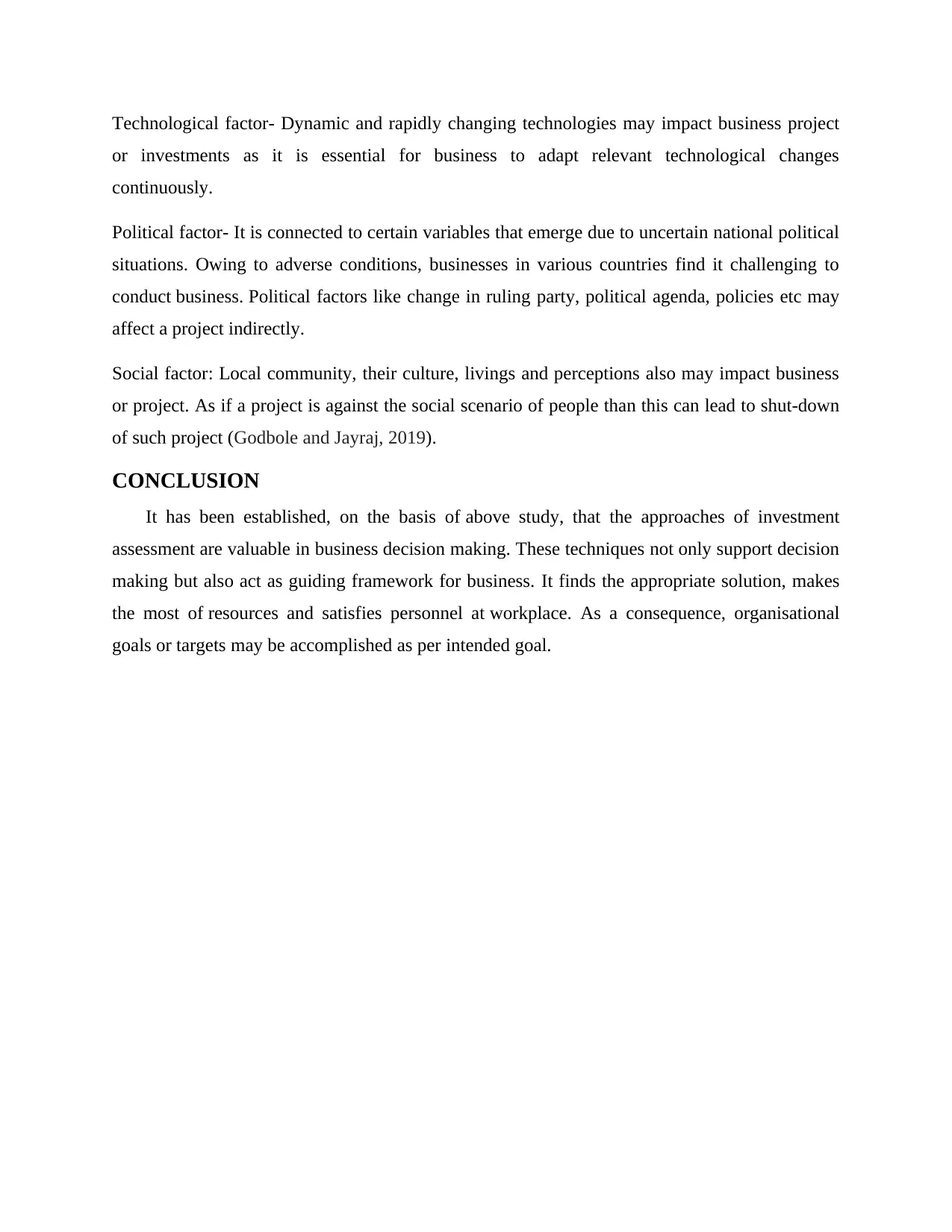
Technological factor- Dynamic and rapidly changing technologies may impact business project
or investments as it is essential for business to adapt relevant technological changes
continuously.
Political factor- It is connected to certain variables that emerge due to uncertain national political
situations. Owing to adverse conditions, businesses in various countries find it challenging to
conduct business. Political factors like change in ruling party, political agenda, policies etc may
affect a project indirectly.
Social factor: Local community, their culture, livings and perceptions also may impact business
or project. As if a project is against the social scenario of people than this can lead to shut-down
of such project (Godbole and Jayraj, 2019).
CONCLUSION
It has been established, on the basis of above study, that the approaches of investment
assessment are valuable in business decision making. These techniques not only support decision
making but also act as guiding framework for business. It finds the appropriate solution, makes
the most of resources and satisfies personnel at workplace. As a consequence, organisational
goals or targets may be accomplished as per intended goal.
or investments as it is essential for business to adapt relevant technological changes
continuously.
Political factor- It is connected to certain variables that emerge due to uncertain national political
situations. Owing to adverse conditions, businesses in various countries find it challenging to
conduct business. Political factors like change in ruling party, political agenda, policies etc may
affect a project indirectly.
Social factor: Local community, their culture, livings and perceptions also may impact business
or project. As if a project is against the social scenario of people than this can lead to shut-down
of such project (Godbole and Jayraj, 2019).
CONCLUSION
It has been established, on the basis of above study, that the approaches of investment
assessment are valuable in business decision making. These techniques not only support decision
making but also act as guiding framework for business. It finds the appropriate solution, makes
the most of resources and satisfies personnel at workplace. As a consequence, organisational
goals or targets may be accomplished as per intended goal.

REFERENCES
Books and Journals:
Ndanyenbah, T.Y. and Zakaria, A., 2019. Application of Investment Appraisal Techniques by
Small and Medium Enterprises (SMEs) Operators in the Tamale Metropolis, Ghana.
Kengatharan, L. and Clamenthu, D.P., 2017. Use of capital investment appraisal practices and
effectiveness of investment decisions: a study on listed manufacturing companies in Sri
Lanka. University of Jaffna.
Higham, A.P., Fortune, C. and Boothman, J.C., 2016. Sustainability and investment appraisal for
housing regeneration projects. Structural Survey.
Godbole, S.B. and Jayraj, G.K., 2019. PROJECT ECONOMIC APPRAISAL TECHNIQUES IN
CONSTRUCTION INDUSTRY-A COMPARATIVE STUDY.
Books and Journals:
Ndanyenbah, T.Y. and Zakaria, A., 2019. Application of Investment Appraisal Techniques by
Small and Medium Enterprises (SMEs) Operators in the Tamale Metropolis, Ghana.
Kengatharan, L. and Clamenthu, D.P., 2017. Use of capital investment appraisal practices and
effectiveness of investment decisions: a study on listed manufacturing companies in Sri
Lanka. University of Jaffna.
Higham, A.P., Fortune, C. and Boothman, J.C., 2016. Sustainability and investment appraisal for
housing regeneration projects. Structural Survey.
Godbole, S.B. and Jayraj, G.K., 2019. PROJECT ECONOMIC APPRAISAL TECHNIQUES IN
CONSTRUCTION INDUSTRY-A COMPARATIVE STUDY.
1 out of 9
Related Documents
Your All-in-One AI-Powered Toolkit for Academic Success.
+13062052269
info@desklib.com
Available 24*7 on WhatsApp / Email
![[object Object]](/_next/static/media/star-bottom.7253800d.svg)
Unlock your academic potential
© 2024 | Zucol Services PVT LTD | All rights reserved.





